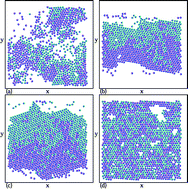Absorbing phase transitions and dynamic freezing in running active matter systems
Abstract
We examine a two-dimensional system of sterically repulsive interacting disks where each particle runs in a random direction. This system is equivalent to a run-and-tumble dynamics system in the limit where the run time is infinite. At low densities, we find a strongly fluctuating state composed of transient clusters. Above a critical density that is well below the density at which non-active particles would crystallize, the system can organize into a drifting quiescent or frozen state where the fluctuations are lost and large crystallites form surrounded by a small density of individual particles. Although all the particles are still moving, their paths form closed orbits. The average transient time to organize into the quiescent state diverges as a power law upon approaching the critical density from above. We compare our results to the random organization observed for periodically sheared systems that can undergo an absorbing transition from a fluctuating state to a dynamical non-fluctuating state. In the random organization studies, the system organizes to a state in which the particles no longer interact; in contrast, we find that the randomly running active matter organizes to a strongly interacting dynamically jammed state. We show that the transition to the frozen state is robust against a certain range of stochastic fluctuations. We also examine the effects of adding a small number of pinned particles to the system and find that the transition to the frozen state shifts to significantly lower densities and arises via the nucleation of faceted crystals centered at the obstacles.


 Please wait while we load your content...
Please wait while we load your content...